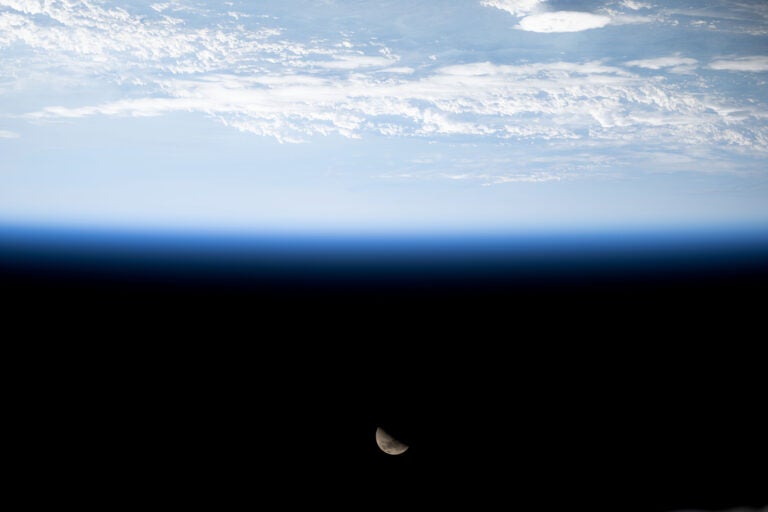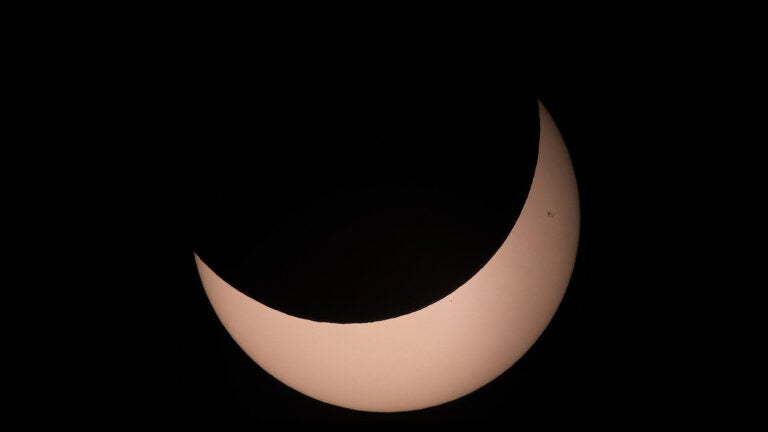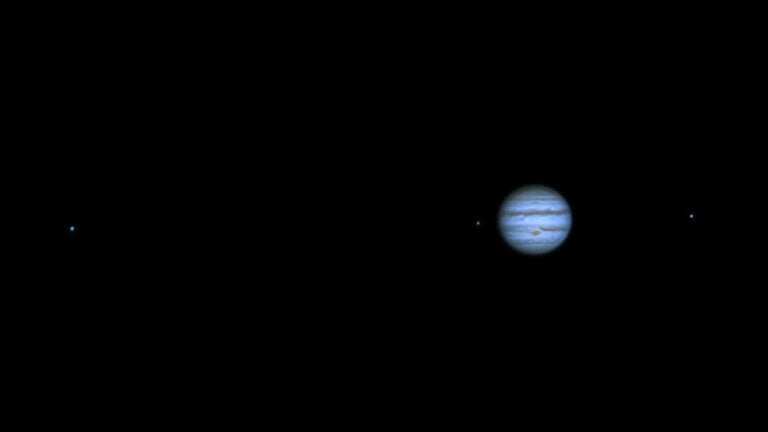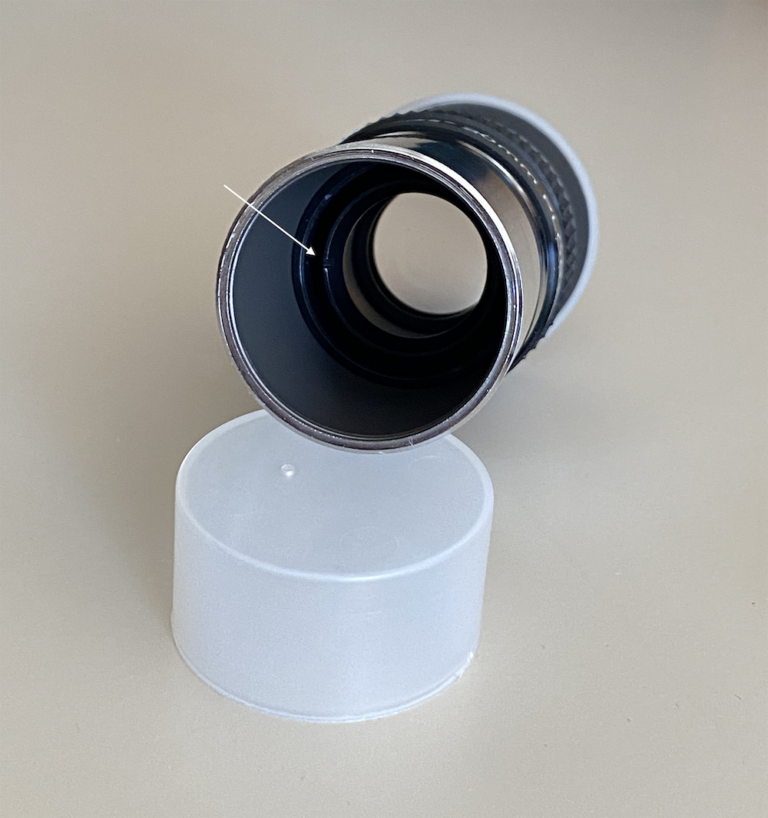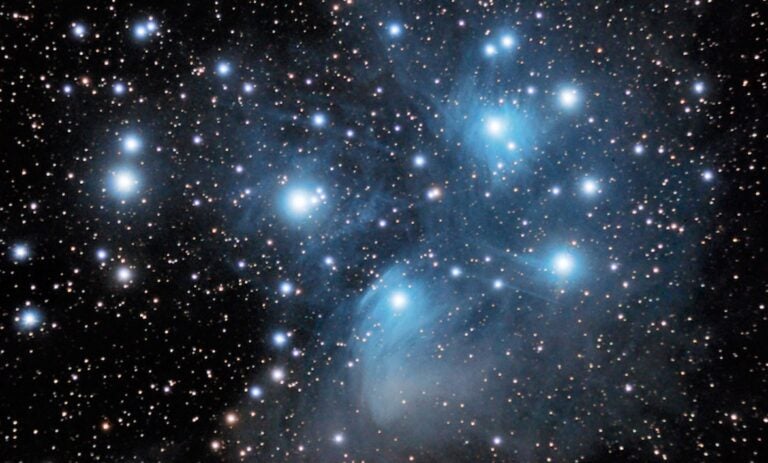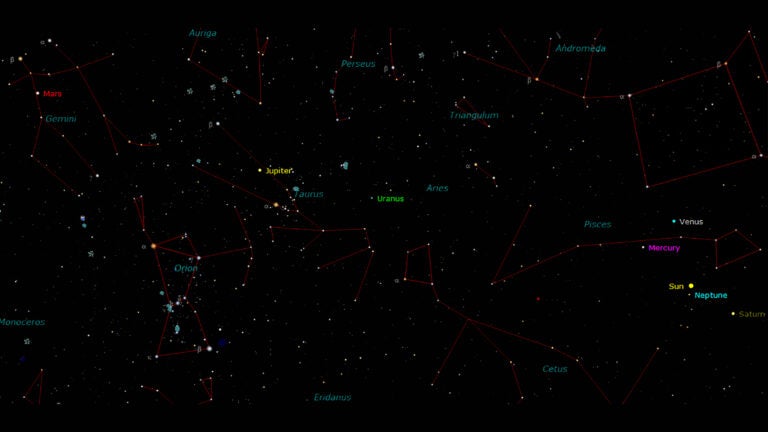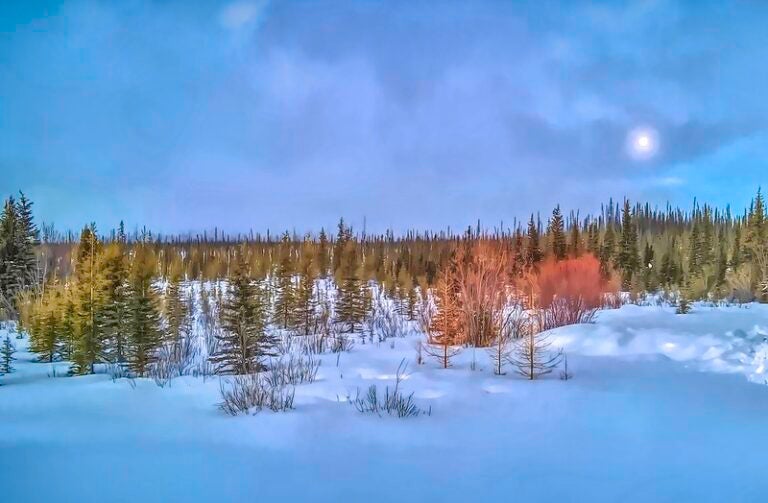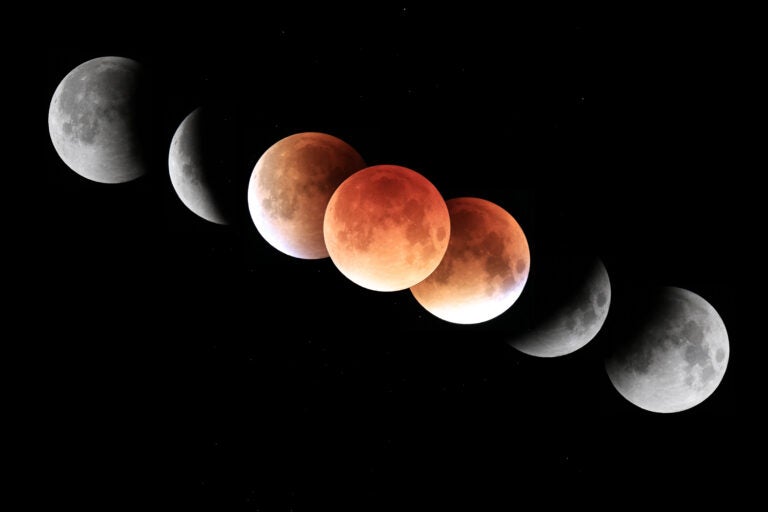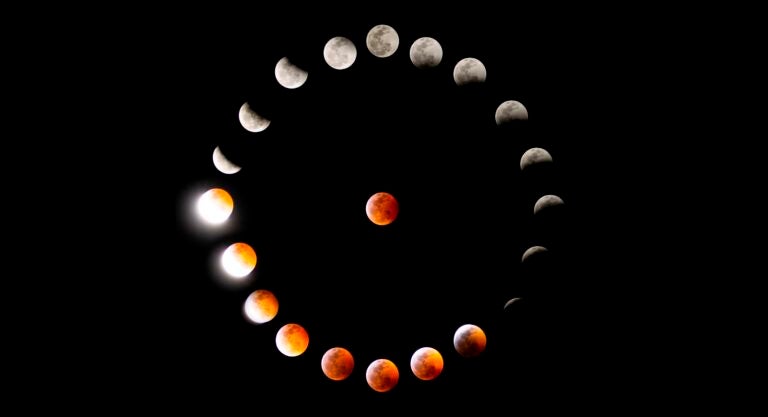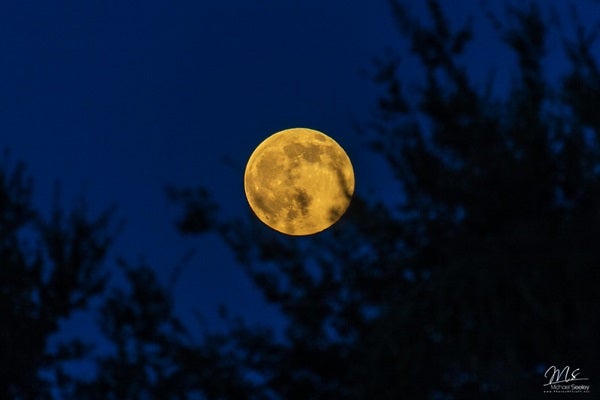
The phenomenon of a Full Moon arises when our planet, Earth, is precisely sandwiched between the Sun and the Moon. This alignment ensures the entire side of the Moon that faces us gleams under sunlight. Thanks to the Moon’s orbit around Earth, the angle of sunlight hitting the lunar surface and being reflected back to our planet changes. That creates different lunar phases.
The next Full Moon will be the Pink Moon, which occurs at 8:22 p.m. on Saturday, April 12, 2025.
We’ll update this article multiple times each week with the latest moonrise, moonset, Full Moon schedule, and some of what you can see in the sky each week.
Here’s the complete list of Full Moons this year and their traditional names.
2025 Full Moon schedule and names of each
(All times Eastern; * denotes a Super Moon.)
- Monday, Jan. 13 — 5:27 p.m. — Wolf Moon
- Wednesday, Feb. 12 — 8:53 a.m. — Snow Moon
- Friday, March 14 — 2:55 a.m. — Worm Moon
- Saturday, April 12 — 8:22 p.m. — Pink Moon
- Monday, May 12 — 12:56 p.m. — Flower Moon
- Wednesday, June 11 — 3:44 a.m. — Strawberry Moon
- Thursday, July 10 — 4:37 p.m. — Buck Moon
- Saturday, Aug. 9 — 3:55 a.m. — Sturgeon Moon
- Sunday, Sept. 7 — 2:09 p.m. — Corn Moon
- Monday, Oct. 6 — 11:48 p.m. — Hunter’s Moon*
- Wednesday, Nov. 5 — 8:19 a.m. — Beaver Moon*
- Thursday, Dec. 4 — 6:14 p.m. — Cold Moon*
The phases of the Moon in February 2025
The images below show the day-by-day phases of the Moon in February. The Full Moon this month was on Friday, March 14.
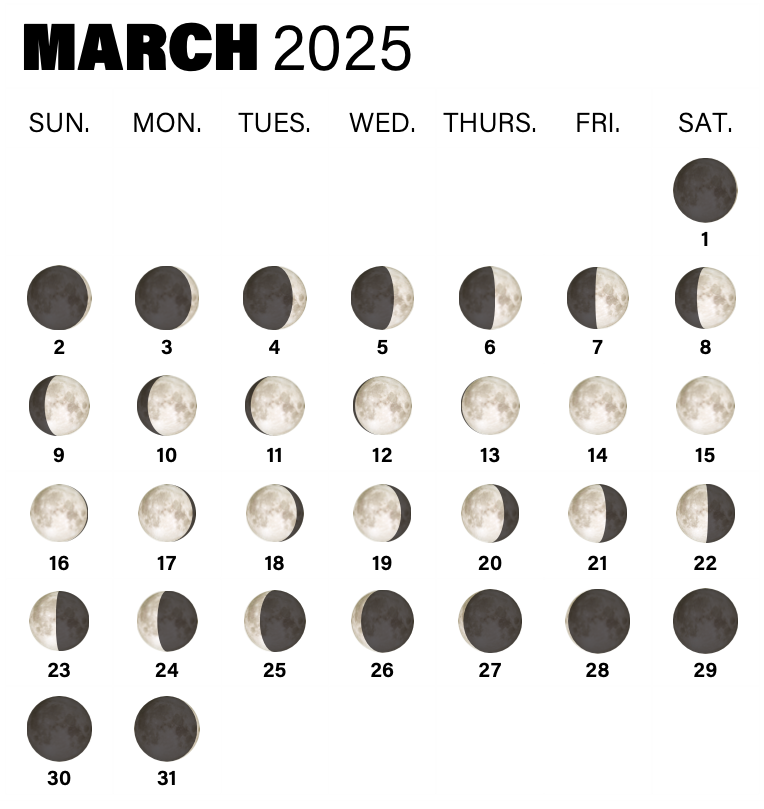
The moonrise and moonset schedule this week
The following is adapted from Alison Klesman’s The Sky This Week column. Times for sunrise, sunset, moonrise, and moonset are given in local time from 40° N 90° W. The Moon’s illumination is given at 12 P.M. local time from the same location.
Friday, March 28
Rising very shortly before the Sun are Mercury, Saturn, and the Moon. The planets cannot be seen; the Moon can be safely viewed with the naked eye but will similarly be extremely challenging to find, as it is a mere 1 percent lit and quickly approaching New phase. Nonetheless, sharp-eyed observers with that clear eastern horizon may get lucky and spot it in the moments before sunrise.
The Moon will pass 9° south of Venus at 10 A.M. EDT this morning.
Sunrise: 6:50 A.M.
Sunset: 9:21 P.M.
Moonrise: 6:24 A.M.
Moonset: 6:43 P.M.
Moon Phase: Waning crescent (1%)
Saturday, March 29
New Moon occurs at 6:58 A.M. EDT. Following the total lunar eclipse that occurred earlier this month, the current celestial lineup of the Sun, Moon, and Earth now brings a partial solar eclipse, visible across parts of western Europe and Africa, the arctic, and northeastern North and South America.
Watch: This Week in Astronomy with Dave Eicher: A Solar Eclipse
Because this is a partial solar eclipse, no part of the event will be safe to look at with the naked eye. You must view the entire eclipse, from start to finish, using eclipse glasses, a solar filter, or a pinhole viewer.
The amount of the Sun blocked will depend on your location. From the UK, about a third of the Sun will disappear behind the Moon, while in Canada, where greatest eclipse will occur, more than 90 percent of the Sun will lie behind the Moon’s disk, leaving only a thin sliver of our star visible.
In the U.S., the eclipse occurs from about 4:50 A.M. to 8:43 A.M. EDT, meaning the eclipse is already underway as the Sun rises on the East Coast. The farther north and east you are, the more of the Sun will be blocked, with the greatest coverage in northeastern Maine. From New York City, the Sun will be about 22 percent obscured at maximum eclipse, while in Washington, D.C., only 1 percent of the Sun will be clipped by the Moon. In these areas, maximum eclipse occurs within minutes of sunrise, so make sure you get out to a location with a clear eastern horizon for the best views.
You can find more details about the eclipse and look up whether and when it will occur from your location on timeanddate.com.
Sunrise: 6:48 A.M.
Sunset: 9:22 P.M.
Moonrise: 6:49 A.M.
Moonset: 8:01 P.M.
Moon Phase: New
Sunday, March 30
The Moon reaches perigee, the closest point to Earth in its orbit, at 1:25 A.M. EDT. At that time, our satellite will sit 222,530 miles (358,127 kilometers) away.
Sunrise: 6:47 A.M.
Sunset: 9:23 P.M.
Moonrise: 7:16 A.M.
Moonset: 9:21 P.M.
Moon Phase: Waxing crescent (2%)
Monday, March 31
The crescent Moon stands 8° west of Uranus tonight, slowly setting in the west after the sky grows dark. By 9:30 P.M. local daylight time, the Moon is some 10° above the western horizon, located in central Aries. To its upper left, Uranus lies just over the border in Taurus. Binoculars or a telescope will show the magnitude 5.8 planet, which lies less than 0.5° east of a brighter magnitude 6.5 field star.
Sunrise: 6:45 A.M.
Sunset: 9:24 P.M.
Moonrise: 7:47 A.M.
Moonset: 10:42 P.M.
Moon Phase: Waxing crescent (8%)
Tuesday, April 1
The Moon now passes 5° north of Uranus at 10 A.M. EDT.
Observers in parts of western Europe and northwestern Africa will see the Moon cross in front of the Pleiades this evening in an occultation that takes place during daylight for those in North America.
Less than four days old, the crescent Moon takes about two hours to pass through the northwestern region of the cluster, beginning shortly after 9 P.M. British Summer Time. Naked-eye observers will see only the brightest stars disappear, while binoculars or even a small telescope will show many more stars winking out as the dark limb of the Moon passes between them and Earth from our point of view. Larger telescopes will show even more faint stars briefly blotted out by the Moon.
Sunrise: 6:43 A.M.
Sunset: 9:25 P.M.
Moonrise: 8:23 A.M.
Moonset: —
Moon Phase: Waxing crescent (15%)
Wednesday, April 2
Moving along the ecliptic, the Moon passes 6° north of Jupiter at 8 P.M. EDT. You can enjoy the pair in the western sky long after sunset, with the Moon hanging to the upper right of bright Jupiter, both in Taurus the Bull.
Sunrise: 6:42 A.M.
Sunset: 9:26 P.M.
Moonrise: 9:08 A.M.
Moonset: 12:02 A.M.
Moon Phase: Waxing crescent (25%)
Thursday, April 3
Sunrise: 6:40 A.M.
Sunset: 9:27 P.M.
Moonrise: 10:02 A.M.
Moonset: 1:15 A.M.
Moon Phase: Waxing crescent (35%)
Friday, April 4
First Quarter Moon occurs at 10:15 P.M. EDT. Our satellite is now in Gemini, quickly catching up to Mars. Tonight, you can find it below Castor and Pollux, the heads of the Twins. Just look southwest an hour after sunset.
During this phase, half of the Moon’s nearside is in daylight and half is still covered by shadow. The terminator, the line that divides lunar night from day, runs down the middle of the visible disk. For the most striking views, use binoculars or a telescope to sweep your gaze along the terminator, where sunrise is essentially occurring on the Moon as you watch. That sunrise is sweeping across the landscape at a speed of some 9.6 mph (15.4 km/h). Look especially along crater walls near the terminator, where sharp-eyed observers can notice the shadows visibly change over the course of three to four hours.
Sunrise: 6:38 A.M.
Sunset: 9:28 P.M.
Moonrise: 11:06 A.M.
Moonset: 2:18 A.M.
Moon Phase: Waxing crescent (46%)
Saturday, April 5
Sunrise: 6:37 A.M.
Sunset: 9:29 P.M.
Moonrise: 12:14 P.M.
Moonset: 3:09 A.M.
Moon Phase: Waxing gibbous (57%)
The phases of the Moon
The phases of the Moon are: New Moon, waxing crescent, First Quarter, waxing gibbous, Full Moon, waning gibbous, Last Quarter, and waning crescent. A cycle starting from one Full Moon to its next counterpart, termed the synodic month or lunar month, lasts about 29.5 days.
Though a Full Moon only occurs during the exact moment when Earth, Moon, and Sun form a perfect alignment, to our eyes, the Moon seems Full for around three days.
RELATED: 20 things to see on the Moon
Different names for different types of Full Moon
There are a wide variety of specialized names used to identify distinct types or timings of Full Moons. These names primarily trace back to a blend of cultural, agricultural, and natural observations about the Moon, aimed at allowing humans to not only predict seasonal changes, but also track the passage of time.
For instance, almost every month’s Full Moon boasts a name sourced from Native American, Colonial American, or other North American traditions, with their titles mirroring seasonal shifts and nature’s events.
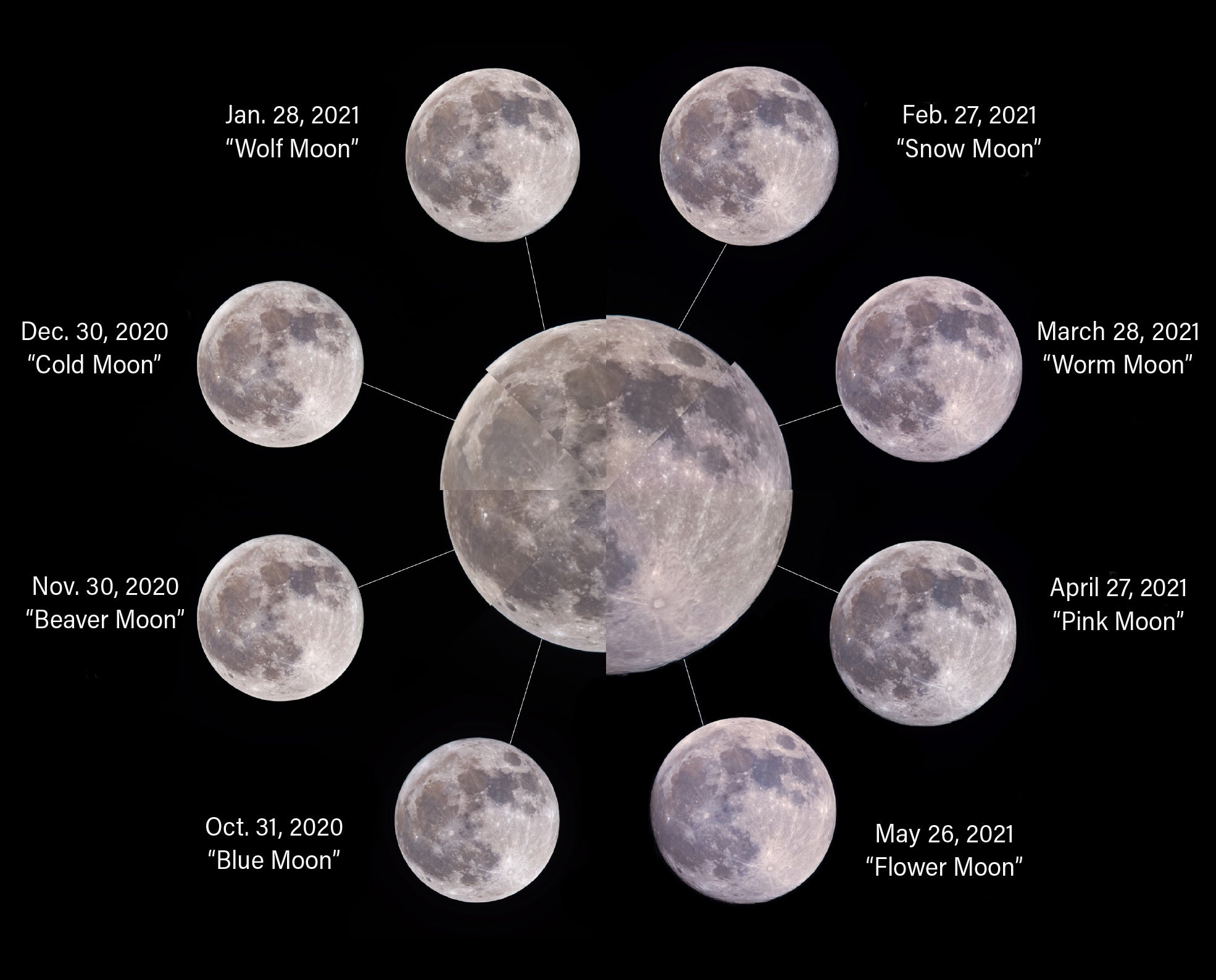
Wolf Moon (January): Inspired by the cries of hungry wolves.
Snow Moon (February): A nod to the month’s often heavy snowfall.
Worm Moon (March): Named after the earthworms that signal thawing grounds.
Pink Moon (April): In honor of the blossoming pink wildflowers.
Flower Moon (May): Celebrating the bloom of flowers.
Strawberry Moon (June): Marks the prime strawberry harvest season.
Buck Moon (July): Recognizing the new antlers on bucks.
Sturgeon Moon (August): Named after the abundant sturgeon fish.
Corn Moon (September): Signifying the corn harvesting period.
Hunter’s Moon (October): Commemorating the hunting season preceding winter.
Beaver Moon (November): Reflects the time when beavers are busy building their winter dams.
Cold Moon (December): Evocative of winter’s chill.
In addition, there are a few additional names for Full Moons that commonly make their way into public conversations and news.
Super Moon: This term is reserved for a Full Moon that aligns with the lunar perigee, which is the Moon’s nearest point to Earth in its orbit. This proximity renders the Full Moon unusually large and luminous. For a Full Moon to earn the Super Moon tag, it should be within approximately 90 percent of its closest distance to Earth.
Blue Moon: A Blue Moon is the second Full Moon in a month that experiences two Full Moons. This phenomenon graces our skies roughly every 2.7 years. Though the term suggests a color, Blue Moons aren’t truly blue. Very occasionally, atmospheric conditions such as recent volcanic eruptions might lend the Moon a slightly blueish tint, but this hue isn’t tied to the term.
Harvest Moon: Occurring closest to the autumnal equinox, typically in September, the Harvest Moon is often renowned for a distinct orange tint it might display. This Full Moon rises close to sunset and sets near sunrise, providing extended hours of bright moonlight. Historically, this was invaluable to farmers gathering their produce.
Common questions about Full Moons
What is the difference between a Full Moon and a New Moon? A Full Moon is witnessed when Earth is between the Sun and the Moon, making the entire Moon’s face visible. Conversely, during a New Moon, the Moon lies between Earth and the Sun, shrouding its Earth-facing side in darkness.
How does the Full Moon influence tides? The Moon’s gravitational tug causes Earth’s waters to bulge, birthing tides. During both Full and New Moons, the Sun, Earth, and Moon are in alignment, generating “spring tides.” These tides can swing exceptionally high or low due to the combined gravitational influences of the Sun and Moon.
Here are the dates for all the lunar phases in 2025:
| New | First Quarter | Full | Last Quarter |
|---|---|---|---|
| Jan. 6 | Jan. 13 | Jan. 21 | |
| Jan. 29 | Feb. 5 | Feb. 12 | Feb. 20 |
| Feb. 27 | March 6 | March 14 | March 22 |
| March 29 | April 4 | April 12 | April 20 |
| April 27 | May 4 | May 12 | May 20 |
| May 26 | June 2 | June 11 | June 18 |
| June 25 | July 2 | July 10 | July 17 |
| July 24 | Aug. 1 | Aug. 9 | Aug. 16 |
| Aug. 23 | Aug. 31 | Sept. 7 | Sept. 14 |
| Sept. 21 | Sept. 29 | Oct. 6 | Oct. 13 |
| Oct. 21 | Oct. 29 | Nov. 5 | Nov. 12 |
| Nov. 20 | Nov. 28 | Dec. 4 | Dec. 11 |
| Dec. 19 | Dec. 27 |

